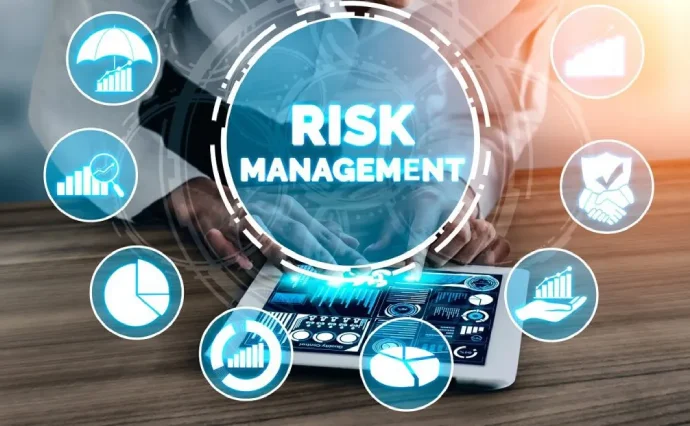Understanding Financial Risk Management In today’s world, managing risks is more important than ever. Financial Risk Management is all about identifying, analyzing, and taking action to minimize financial risks. It helps businesses and individuals protect their money from unexpected changes in the economy. Financial risk management is a key part of keeping investments safe and growing them over time. In this article, we will explore what financial risk management means, why it is important, and how it works in the real world.
What is Financial Risk Management?
Financial Risk Management: An Overview
Financial risk management is a process commonly used to manage the possibility of financial loss. The goal is to identify risks that could harm a business or individual’s financial situation and find ways to reduce or eliminate these risks. Furthermore, it can involve assessing market conditions, interest rates, currency fluctuations, or changes in creditworthiness. By understanding these risks, people and businesses can make better decisions to protect their finances..
Why Financial Risk Management Matters
The Importance of Financial Risk Management
Financial risk management is essential because it helps businesses and individuals avoid financial disasters. Without proper risk management, companies can lose large amounts of money, and investors can face severe losses. Effective financial risk management helps in making informed decisions that can lead to stability and growth, even in uncertain times.

Types of Financial Risks
Key Financial Risks to Manage
Market Risk: Market risk involves the possibility that the value of an investment will decrease due to changes in the market. This could be caused by things like stock prices going down or interest rates going up.
Credit Risk: Credit risk is the risk that a borrower will not repay a loan. Banks and lenders face credit risks every day when they lend money to individuals and businesses.
Liquidity Risk: Liquidity risk happens when a company or individual cannot quickly turn assets into cash without a significant loss. This can make it hard to meet financial obligations.
Operational Risk: Operational risk is related to internal failures within a company, such as technology breakdowns, human errors, or fraudulent activities.
Currency Risk: Currency risk arises when the value of a country’s currency changes. For businesses that operate internationally, this can affect profits and expenses.
How to Manage Financial Risks
Strategies for Effective Financial Risk Management
Diversification: One of the best ways to manage financial risk is through diversification. This means spreading investments across different types of assets, industries, or regions to reduce exposure to any single risk.
Hedging: Hedging involves using financial instruments, like derivatives, to protect against potential losses. For example, a company might use hedging to protect itself from changes in interest rates or currency values.
Insurance: Companies and individuals can use insurance to protect against certain risks, such as natural disasters, lawsuits, or accidents.
Setting Limits: Businesses can set limits on how much risk they are willing to take. This can involve controlling how much money is invested in high-risk ventures or limiting the amount of debt they take on.
Financial Risk Management Tools
Tools Used in Financial Risk Management
There are many tools available for managing financial risks. Some of these tools include:
Risk Assessment Software: Companies use specialized software to analyze financial risks and predict potential outcomes.
Financial Modeling: Financial models help businesses forecast future financial performance and assess the impact of various risks.
Stress Testing: Stress testing involves creating hypothetical scenarios to see how different risks might affect a business. This helps companies prepare for worst-case situations.
The Role of Financial Risk Managers
What Do Financial Risk Managers Do?
Financial risk managers are professionals who help businesses and individuals understand and manage financial risks. Moreover, they use tools like data analysis, financial models, and risk assessments to guide decision-making. A financial risk manager’s goal is to protect their clients from significant financial losses while also identifying opportunities for growth.
Benefits of Financial Risk Management
Why Financial Risk Management is Beneficial
Increased Stability: Effective risk management provides businesses and individuals with greater financial stability. It helps them avoid sudden financial crises and plan for the future.
Improved Decision Making: By understanding potential risks, companies can make better decisions about investments and operations.
Cost Savings: Managing financial risks can save businesses and individuals money by preventing costly mistakes or losses.
Competitive Advantage: Companies that manage risks effectively can gain a competitive advantage by being better prepared for market changes or financial downturns.
Challenges in Financial Risk Management
Common Challenges in Managing Financial Risks
Unpredictability: The biggest challenge in financial risk management is that risks can be unpredictable. Market conditions, interest rates, or global events can change quickly, making it hard to anticipate all risks.
Complexity: Financial risk management can be complex, especially for large companies that operate in multiple countries or industries.
Data Accuracy: Risk managers rely on accurate data to make decisions, but sometimes the data may be incomplete or outdated, leading to incorrect conclusions.
Human Error: Mistakes made by people, such as data entry errors or poor decision-making, can lead to ineffective risk management.
Financial Risk Management
Understanding Financial Risk Management
Financial risk management is an important concept in business. It involves identifying, assessing, and managing financial risks. These risks could include anything that might cause a company to lose money. By managing these risks, businesses can avoid big losses. Importantly, it helps keep companies stable and successful. Without it, businesses could face serious financial problems.
Moreover, companies use different tools to manage risks. For example, they might purchase insurance or use financial strategies. By doing so, they protect themselves from unexpected events. However, it’s important to understand what financial risks are before managing them.
Types of Financial Risks
When we talk about financial risks, there are many types. First, there is market risk. This risk happens when the value of investments changes due to the market. For instance, if the stock market crashes, the value of a company’s stocks will go down. As a result, the company could lose a lot of money.
Next, there is credit risk. Credit risk occurs when a borrower cannot repay their loan. If a company gives loans to other businesses or individuals, they may not get their money back. Consequently, they will lose that money.
Lastly, operational risk occurs when something goes wrong in the company’s operations. This could include technical issues, fraud, or poor management. Though it seems different from other risks, it still affects finances.
How to Identify Financial
Risks Identifying financial risks is the first step in managing them. Companies need to understand what risks they might face. They should look at all their business activities. Furthermore, they must study the economy and markets they operate in. By doing this, they can see possible dangers.
In addition, companies often hire financial experts to help identify risks. These experts use tools like financial models and data analysis. After identifying the risks, businesses can prepare strategies to handle them.
Managing Financial Risks Effectively
Once risks are identified, they need to be managed. One common way to do this is through diversification. Diversification means spreading out investments in different areas. For instance, a company may invest in stocks, bonds, and real estate. By doing so, if one investment loses value, others may still perform well.
Another way is through hedging. Hedging involves using financial products like options and futures. These products protect companies from losing money if market prices change. Lastly, companies can also set up emergency funds. These funds help cover unexpected losses.
Tools and Techniques for Financial Risk Management
There are many tools and techniques companies use to manage risks. Some use financial models to predict how much risk they face. These models look at factors like interest rates and market prices. Moreover, companies also use insurance. Insurance helps protect against certain risks like property damage or legal issues.
In addition, some companies use contracts to manage risks. These contracts, called derivatives, can lock in prices for things like oil or wheat. Consequently, companies know exactly how much they will pay or receive in the future.
The Importance of Regular Monitoring
Financial risk management is not a one, time task. Instead, companies need to monitor their risks regularly. This means constantly looking at their investments and the market. Since things can change quickly in the business world, regular checks help avoid surprises..
Furthermore, businesses should review their risk management plans often. They might need to adjust their strategies if they see new risks. For instance, if a new competitor enters the market, a company may need to reconsider its financial plans.
FAQs About Financial Risk Management
Q: What is financial risk management?
Financial risk management involves identifying and managing potential financial losses to protect businesses or individuals.
Q: Why is financial risk management important?
It helps avoid financial disasters and ensures stability and growth in uncertain market conditions.
Q: What are the main types of financial risks?
The key risks are market risk, credit risk, liquidity risk, operational risk, and currency risk.
Q: How can I manage financial risks?
Strategies include diversification, hedging, insurance, and setting risk limits.
Q: What tools are used in financial risk management?
Common tools include risk assessment software, financial modeling, and stress testing.
Q: Who is responsible for managing financial risks?
Financial risk managers help businesses and individuals understand and handle financial risks.
Q: What challenges are faced in financial risk management?
Unpredictability, complexity, data accuracy, and human error are common challenges.
Conclusion: Why Financial Risk Management Matters
To sum up, financial risk management is crucial for all businesses. Additionally, it helps protect them from losing money and keeps them stable. By identifying risks, using tools, and monitoring their strategies, companies can avoid financial problems. Without proper risk management, businesses could face severe losses that threaten their future success..
Financial risk management is crucial for all businesses. Moreover, it helps protect them from losing money and keeps them stable. By identifying risks, using tools, and monitoring their strategies, companies can avoid financial problems. Without proper risk management, businesses could face severe losses that threaten their future success.
Additionally, good financial risk management builds confidence in a company. Investors and customers trust companies that can handle risks well. As a result, this trust leads to growth and long-term success. Therefore, every business should make financial risk management a priority.
In addition, effective financial risk management not only helps prevent financial loss but also promotes long-term growth. By consistently reviewing and updating their risk management strategies, businesses can adapt to changing market conditions and stay competitive. Ultimately, companies that take proactive steps to manage risks are better equipped to navigate financial challenges and seize new opportunities. This ensures a more secure and prosperous future for the business.



